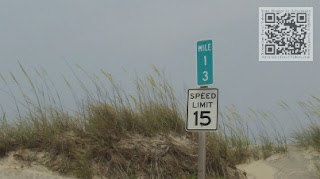Corolla is on the east coast of the United States in North
Carolina (NC), just 5 hours and 290 mi
from Washington DC but the village was a world away until 1955 when electricity
finally arrived. In the 1970s only
about 15 people lived in the village and the paved road stopped 15 miles south of town. In October 1984 the
state took over a private road and made it part of NC Highway 12. The state
extended the road to pass thought Corolla, and it was the village’s first paved
road.
The wild horses of the Currituck Outer Banks have survived
nearly 500 years of fierce Nor’easters and hurricanes. They are truly
representative of the Outer Banks spirit - untamed and rugged - and are an
integral part of what draws visitors to the northern beaches every year.
Nowhere else can you see wild Mustangs walking along the beach and grazing
among beach homes.
Over 7,500 acres of the northern-most
beaches have been defined as a horse sanctuary. As you enter the area you see a
sound-to-sea fence that is use to protect these beautiful animals. The Colonial
Spanish Mustang is on the Critical Breed list of the American Livestock
Conservancy and on the Critical list of the Equus Survival Trust. Colonial
Spanish is a group of related breeds and strains with common ancestors from
stock brought to the New World from Spain.
Accounts of Spanish explorations and colonization attempts
in the early 1500's state that Spanish Barb and Arabian horses were imported.
Present day Corolla and Ocracoke island wild horses carry the distinguishing
features of Spanish type horses. One striking similarity to the Arabian
ancestry is the number of vertebra (one less than most breeds), which occurs in
the Banker Horse Breed.
The Spanish Mustang Registry is satisfied that the Banker
Horses, in particular the Corolla strain, are as lineally pure to the 16th
century Spanish importations as can be found in North America today, and that
they compare closely to the selectively bred South American Spanish derivative
stock.
With all the above information researched, I needed to see
these horses for myself. Thanks to the state of North Carolina the ride to
Corolla was very pleasant, paved all the way.
After some false starts in planning I share with you what we
finally figured. We first thought that we might save some money by not buying a
tour to see the horses but soon learned that the soft beach sand would
overwhelm our Ford Ranger 2x4 truck. We first walked in a bit and only saw
other folks fighting the sand so we backed away. The horses aren’t dumb; they
live a mile or better up the beach. Remember, every mile walked in you need to
walk a mile out!
There are a number of good tour operators. There is no need
to recommend anyone in particular but I do have a specific thought on seating.
Some tours seat you facing-in toward the center of the truck…poor! Select a
tour where you sit facing front. Some of the best pictures are taken coming upon
the horses, not going past, and sitting front you get to look left and right.
Our tour was extended a bit when our drive needed to push another driver out of
a sand rut.
More pictures on http://www.flickr.com/photos/streamline_travel_videos/
See you on the road
Bernie J
Streamline Travel Videos
“Your bridge to adventure”












